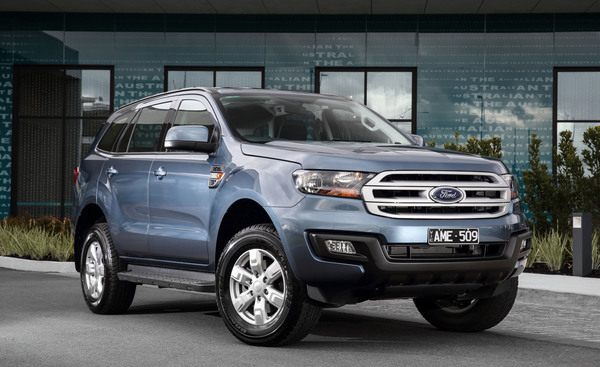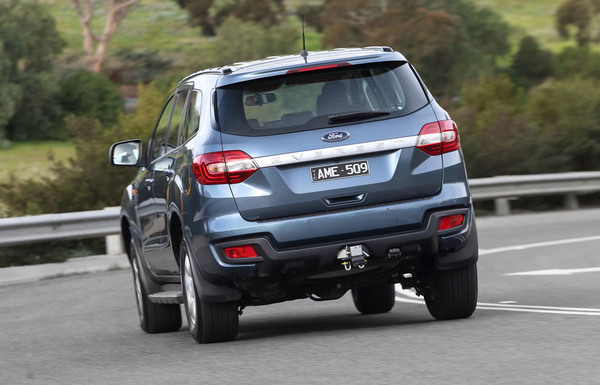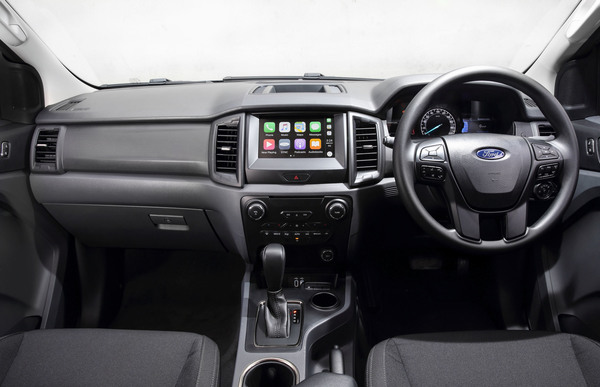
By Alistair Kennedy
Ford Everest is a big, rugged 4WD / SUV that’s been around in other countries since 2003 but didn’t arrive in Australia until the release of the third generation model in late 2015.
Although it’s fully imported from Thailand it is an important model for Ford Australia as the company moves away from vehicle production while retaining local employment by providing technical input through its research and development investment.
Although the arrival of Ford Everest almost dove-tailed with the departure of the popular Territory the two vehicles are quite different. Everest is a serious off-roader that’s built on the same platform as the company’s \ Ranger ute while the locally-produced Territory was a typical urban family wagon based on the Falcon.
Everest, as the name suggests, is big. At just under five metres long and over two metres wide it takes up a fair bit of road space with converts into a versatile and spacious cabin capable of carrying up to seven occupants and gear in relative comfort.
Our Everest road test vehicle was the entry-level Ambiente AWD. It comes with 17-inch alloy wheels which tend to look a bit puny inside the large wheel arches designed to cater for the 20-inchers of the top-spec Titanium.
The big and bold chromed trapezoidal radiator grille is flanked by the latest in integrated projector headlamp / daytime running light set-ups that improves visibility to approaching drivers in poor weather conditions. At the rear there sculpted tail lamps with integrated LED lighting.
The higher specced Trend and Titanium models also get running boards.
Everest is available in three variants, Ambiente, Trend and Titanium spanning a price range from $47,990 to $74,701. The entry-level Ambiente has five seats with a pair of third-row seats available for an additional $1000. Trend and Titanium models have seven seats.
Ambiente and Trend come with either rear- or four-wheel drive.
All Everest models are powered by Ford’s 3.2-litre five-cylinder turbo-diesel Duratorq engine as used in the Ranger. It generates 147 kW of power at 3000 rpm and torque of 470 Nm from 1750 to 2500 revs. Towing capacity of up to 3000 kg is offered if the trailer is braked.
It’s not the quietest diesel engine we’ve encountered but shouldn’t be an issue with a vehicle of this sort.
The only gearbox is a six-speed automatic.
For off-road driving Everest uses Ford’s Terrain Management System (TMS) to alter throttle response, transmission, traction control and an intelligent four-wheel drive system to maximise performance under varying conditions. From a knob on the centre console the driver can select from normal, snow, gravel, grass, sand or rock.
The control also incorporates hill descent control, which can be activated in any conditions. An electronic locking rear differential helps prevent the rear wheels from spinning while driving off-road, increasing traction in difficult terrain. It can be locked automatically when using off-road TMS modes, or switched manually using the differential lock button.
All Everests are available with seven seats, either standard or as an option. The second row slides forward far enough to improve access to the back row.
Two adults and three children can travel in comfort although a third adult can get into the centre middle row with a fair bit of elbow contact. The second row seats have a 60/40 split and the third row 50/50. With all seats in place there is a reasonable 450 litres of storage space left.
Lowering the third seats (there is a power-fold facility) extends that to 1050 litres while with all five rear seats down it can carry up to 2010 litres.
Ambiente and Trend have cloth seats, Titanium gets leather trim.
There are air conditioning vents and controls at the back of the centre console to assist rear passenger comfort. All Everest models get dual-zone climate control. There’s a power-operated tailgate in the Trend and Titanium.
The twin drink holders between the front seats are far too shallow to adequately hold any but the smallest of containers – an accident waiting to happen.
All Everest models employ an 8.0-inch colour touchscreen for infotainment system display and control together with a 4.2-inch colour instrumentation screen for driving data. The system uses Ford’s Sync3 connectivity system with Applink and enhanced voice control. It syncs with both Apple CarPlay and Android Auto.
Trend and Titanium get satellite navigation with a traffic message channel.
The audio system includes DAB+ digital and 10 speakers with Aux, iPod, USB and SD card input ports. The ports are sensibly located at the rear of a smartphone-sized pocket at the base of the dashboard.
Ford Everest has been awarded a five-star ANCAP rating.
Standard safety equipment in all models includes seven airbags with curtain ‘bags covering all three seat rows; enhanced ABS brakes; trailer sway control; reversing camera and rear parking sensors, the last two features a bonus in such a large vehicle.
The mid-spec Trend adds halogen daytime running lights; front parking sensors; adaptive cruise control with forward collision alert; lane-keeping assist; and auto high-beam control.
Titanium tops off the safety feature list with tyre pressure monitoring; blind spot monitoring; active park assist; LED daytime running lights; and, one of our favourites, rear cross-traffic alert which warns of approaching vehicles when reversing out of front-in parking spots.
Our Ambiente used a key-in-ignition engine start, which is still my preferred method. No problem during the day but because the keyhole is located behind the steering wheel and isn’t illuminated at night it frequently proved difficult to find. We even had to either turn on the interior lights or open the front door to locate it.
Everest’s Aussie engineering input shows in its excellent balance of rugged off-road capability and refined on-road manners enhanced by the Terrain Management System.
On the open road our AWD Everest proved surprisingly stable through moderately sharp corners noticeably less body roll than we found in some competitors. Steering is precise and responsive.
We didn’t get the opportunity to use the optional towing pack but with Everest’s peak torque starting at 1750 rpm we’ve no doubt that low-down pulling power would have no trouble with the typical Australian cargo of horse float or boat.
We did do a couple of laps around our local rough track and found just how well the big Ford coped with sections of rocky and rutted terrain.
There’s plenty of ground clearance and the TMS combined with the traction control and accessible torque proved suggested that it could handle much more extended and challenging tests. We might have to try and schedule one in!
Interior noise has been reduced through the use of sound-deadening under the bonnet, in the floor and firewall giving the big Ford a more refined, SUV rather than pickup, feel.
We split our fuel consumption readings between the on-road and off-road segments of our week-long road test. On the suburban / motorway component we logged an impressive 7.1 litres per 100 kilometres on the motorway. However, true to form, the beast devoured anything up to 16 litres of diesel per 100 prowling around town.
With local vehicle production all but finished our locally-based companies are searching for means of proving that they can still make contributions to the industry. New Ford Everest is a promising example of how Aussie know-how can be utilised around the world. Let’s hope this is just the beginning.
Inquire about the Ford range at Berwick Ford, 749 Princes Highway, Berwick, phone 8768 2222, Freeway Ford, 200 High Street, Cranbourne, phone 5991 2300 or Pakenham Ford, 208 Princes Highway, Pakenham, phone 5941 0600.
MODEL RANGE
Ambiente 3.2-litre turbo-diesel RWD five-seat: $47,990
Ambiente 3.2-litre turbo-diesel RWD seven-seat: $48,990
Ambiente 3.2-litre turbo-diesel 4WD five-seat: $52,990
Ambiente 3.2-litre turbo-diesel 4WD seven-seat: $53,990
Trend 3.2-litre turbo-diesel RWD seven-seat: $53,990
Trend 3.2-litre turbo-diesel 4WD seven-seat: $58,990
Titanium 3.2-litre turbo-diesel 4WD seven-seat: $74,701









